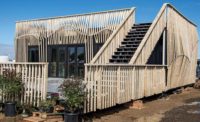DPR Reston Net-Zero Energy Office
Reston, Va.
Best Project
Owner/General Contractor: DPR Construction
Lead Design Firm/Electrical Engineer: SmithGroupJJR
Structural Engineer: McMullan & Associates Inc.
MEP Engineer: Southland Industries
Subcontractors: M.C. Dean Inc. (Electrical/Fire Alarm); Facchina Construction Co. (Concrete); Structural Preservation Systems LLC (Masonry); Kensington Glass Arts Inc.; Capital City Flooring
Rather than building new, DPR chose to renovate a 20,000-sq-ft space that had been vacant for more than seven years. Designed to achieve net-zero energy use, the space incorporates numerous sustainable elements as well as data-driven decisions to create what DPR calls a “living laboratory” that showcases technologies, products and systems.
The building uses traditional fan-powered terminal units and radiant sails that allow the space to simultaneously heat and cool in various areas of the office.
The entire interior is illuminated by 24 SolaTubes, allowing substantial amounts of natural daylight to come in while using little energy throughout the day. The LED lighting system, combined with an automated sensor system, provides a consistent level of lighting through the day while maximizing energy savings.
The 141-kW photovoltaic system is designed to provide 10% more energy than required to achieve a net-zero energy certification. The Sun Power Helix photovoltaic system is one of the first of its kind on the East Coast, according to DPR.
The building also features a dashboard that provides real-time energy and water consumption data as well as energy produced by the photovoltaic array.
The team installed four different finished concrete options to see what each would cost, look like and hold up under normal office wear and tear. DPR carpenters installed reclaimed wood taken from barns in Connecticut and the Maryland Eastern Shore.
The team incorporated concepts of the WELL Building Standard across the project, including healthy food options and access to a fitness center.
Early collaboration was required on the job among the design-build team members. DPR used its dual role as owner and general contractor to its benefit. It says it gleaned a better understanding of the impacts of all decisions and the effects on cost, schedule and quality. The company adds, however, that handling the general contractor and owner roles also was a challenge because its deep involvement with the project gave it a heightened interest in working as a team with the architect and engineers so that changes during construction could be implemented while maintaining schedule, cost and quality.
Related Article: Region’s Best Work Meets Big Challenges






